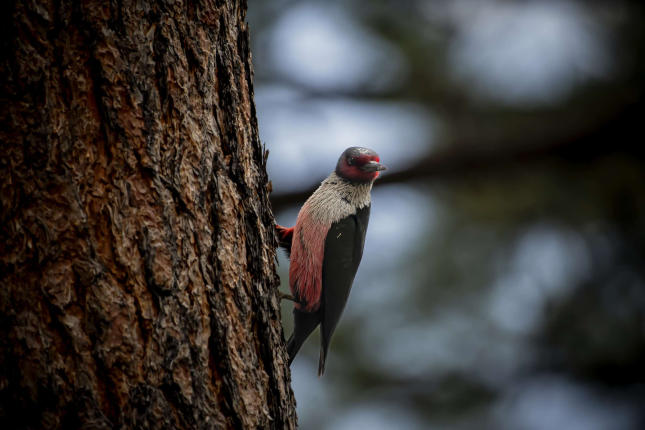Bird of the Month: Lewis's Woodpecker
Meet Lewis's Woodpecker (Melanerpes lewis), a beautiful and unconventional woodpecker of the western US. Named after Meriwether Lewis of the famed Lewis and Clark expedition, this striking bird sports a deep green back, pinkish belly, and a dark red face, setting it apart from its black-and-white spotted cousins. Though a member of the woodpecker family, Lewis's Woodpecker often behaves more like a flycatcher, gliding gracefully through the air and catching insects mid-flight. Their unique appearance and behavior make them a memorable sight for birders across the West.
.
Lewis's Woodpecker is a medium-sized bird, typically 10-11 inches in length with a wingspan of about 20 inches. Despite belonging to the same family as Downy and Hairy Woodpeckers, it stands out not just in appearance but also in its more aerial feeding behavior. Its coloration is unlike any other North American woodpecker and males and females look similar, which makes sexing them by sight difficult.
Lewis's Woodpeckers are most commonly found in open ponderosa pine forests, cottonwood groves, and oak savannas, particularly in the western U.S. and southern British Columbia. They are year-round residents in Colorado, one of 11 species commonly found in Colorado. Like most woodpeckers, they prefer areas with standing dead trees (snags), which provide essential nesting cavities. Because of their dependence on specific habitats, they are often considered an indicator species for the health of open woodland ecosystems.
Lewis's Woodpeckers are also known for being somewhat nomadic. While many woodpeckers maintain year-round territories, Lewis's Woodpeckers are more likely to wander in search of food, especially in fall and winter. This can make them difficult to locate and contributes to their sometimes mythical status among birdwatchers.
Lewis's Woodpeckers are omnivores with a seasonal diet. During warmer months, they catch flying insects in the air—a feeding strategy called "hawking." They perch quietly, scanning for prey before launching into agile flights. Their flight is more reminiscent of a jay than a woodpecker, often described as slow and graceful with steady wingbeats instead of bouncy like most other woodpeckers.
In the fall and winter, their diet shifts primarily to nuts and fruits. Acorns, cherries, berries, and other mast crops are favorites. They are known to cache food in crevices, bark, and cavities, particularly in the fall. This behavior helps them survive when food is scarce, much like the Acorn Woodpecker or Jays.
They are not frequent backyard visitors but they can be attracted to suet, peanuts, and other high-energy foods.
Lewis's Woodpeckers are monogamous and typically form breeding pairs in the spring. Courtship is relatively understated compared to other woodpecker species, involving simple displays such as calling, mutual preening, and short chases.
Nesting begins with the excavation or selection of a tree cavity, usually in a dead or decaying tree. Sometimes they use natural cavities or reuse those made by other woodpeckers. The female lays 5-9 white eggs, and both parents share incubation duties over the 12-14 day incubation period.
Once the eggs hatch, both parents are attentive and cooperative in feeding the chicks. The young fledge approximately 4 weeks after hatching but may continue to be fed by parents for a short time while they hone their foraging skills. Like their parents, fledglings exhibit a slow, buoyant flight that helps distinguish them even at a young age.
Conservation Concerns: Lewis's Woodpecker populations have been in decline over the past few decades, largely due to habitat loss. Logging, fire suppression, and development have led to a reduction in the open woodland and snag-rich environments they rely on for nesting and foraging.
Fire plays a key role in maintaining the open habitats they prefer, but modern fire suppression policies often lead to dense forests that are unsuitable for this species. Paradoxically, while some wildfires are harmful, others can create the ideal post-burn conditions that Lewis's Woodpeckers need.
Conservation efforts for this species involve preserving and restoring open pine and oak woodlands, allowing for natural fire cycles, and retaining dead trees for nesting. Public education about the ecological value of snags and open forest habitats can also go a long way in supporting this unique species.
A Name for the Future: As bird lovers and conservationists, we have a rare opportunity to shape how future generations relate to the natural world. With the AOS planning to rename bird species currently named after people, we invite you to help reimagine a name for Lewis's Woodpecker.
What name do you think best reflects this bird's spirit, beauty, and unique lifestyle? Perhaps something that honors its graceful flight, its colorful plumage, or its distinctive habitat? We welcome your thoughts and suggestions—send us your ideas, and let’s celebrate this bird's essence together.

